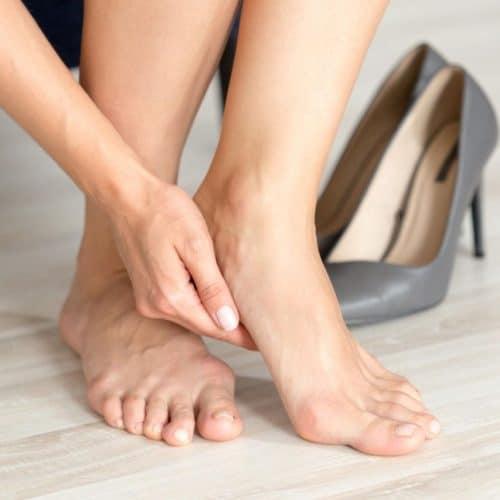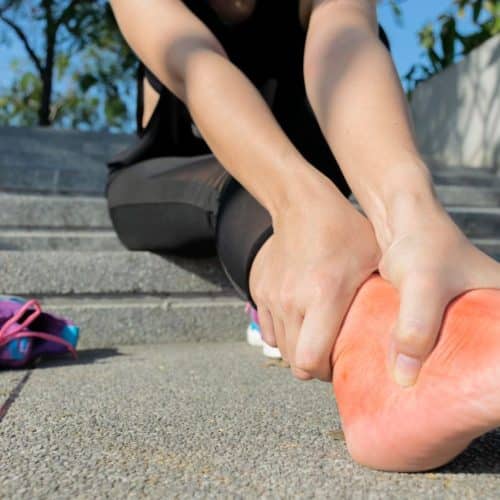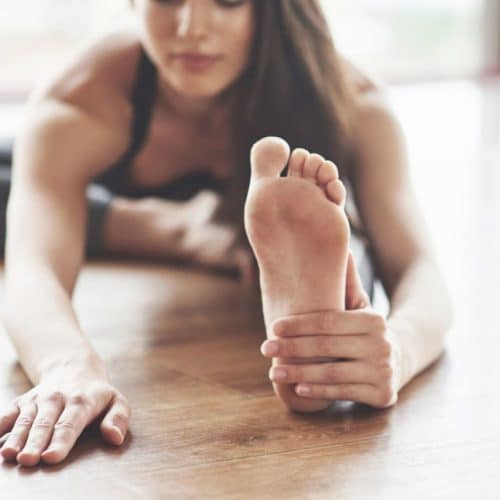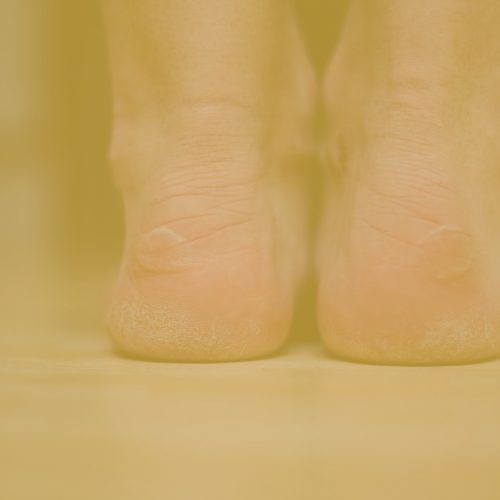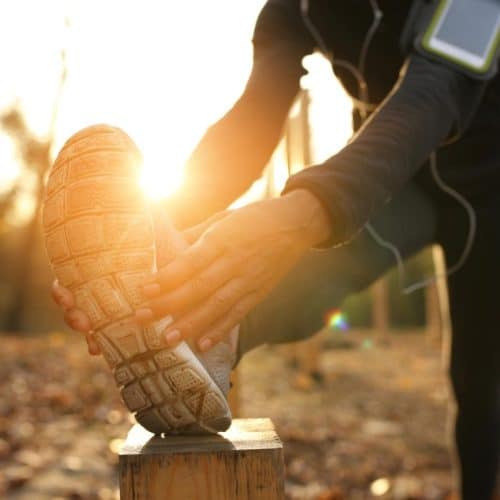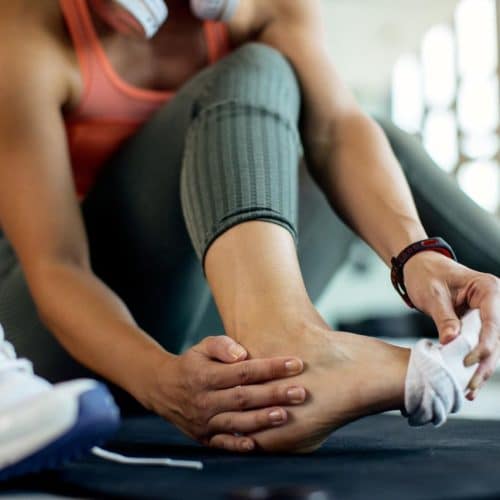Are you tired of enduring persistent knee pain that interferes with your daily activities? Don’t worry; we’ve got you covered! In this article, we’ll reveal a set of simple yet effective moves specifically designed to alleviate knee pain caused by muscle imbalances. Say goodbye to discomfort, get ready to regain mobility, and lead a pain-free life!
Understanding Muscle Imbalances
Muscle imbalances are a common issue that many people may not be aware of, yet they can significantly impact the health and function of our knees. To better comprehend how these imbalances occur and the effects they can have, let’s delve deeper into this crucial aspect of knee pain.
1. How Muscle Imbalances Develop
Muscle imbalances typically arise from our daily habits and activities. Sedentary lifestyles, long periods of sitting, and lack of exercise can contribute to weakened muscles, particularly those around the knees. On the other hand, repetitive movements or overuse of certain muscle groups without adequate rest can lead to tightness and tension in those areas.
Posture also plays a crucial role in the development of muscle imbalances. Poor posture, whether while sitting, standing, or walking, can cause certain muscles to become overactive and others to weaken over time. Additionally, past injuries or trauma to the knees can alter muscle function, leading to imbalances that persist even after the injury has healed.
2. Impact on Knee Health
When there is an imbalance between the muscles around the knee joint, it affects the way forces are distributed during movement. The knee joint is designed to handle a specific load and pressure, but it disrupts this balance when certain muscles are weaker or tighter.
For example, tight quadriceps can pull the kneecap out of alignment, leading to conditions like patellofemoral pain syndrome (PFPS) or “runner’s knee.” On the other hand, weak hamstrings can fail to provide adequate support to the knee during activities like walking, running, or climbing stairs, increasing the risk of strains or sprains.
Muscle imbalances can also affect the surrounding structures of the knee, including ligaments, tendons, and cartilage. As the knee joint tries to compensate for the imbalance, it may lead to abnormal wear and tear, increasing the chances of degenerative conditions like osteoarthritis.
3. Identifying Muscle Imbalances
Recognising muscle imbalances can be challenging as the pain might not always be localised around the knees. People commonly experience pain in their hips, lower back, or ankles due to improper knee alignment caused by muscle imbalances.
Some common signs of muscle imbalances include:
- Uneven wear on the soles of shoes, indicating uneven weight distribution.
- Clicking or popping sounds in the knees during movement.
- A feeling of instability or weakness in the knees.
- Limited range of motion during certain activities.
- Pain that worsens with specific movements or after prolonged sitting or standing.
If you suspect muscle imbalances as the cause of your knee pain, it’s essential to consult a healthcare practitioner or a qualified physical therapist. They can perform a comprehensive assessment and provide tailored exercises and treatment plans to address the imbalances effectively.
4. Preventing and Correcting Muscle Imbalances
The good news is that muscle imbalances can be prevented and corrected with the right approach. Regular exercise that targets all muscle groups, including those around the knees, is crucial for maintaining overall balance and strength.
By including strength training, aerobic activities, and flexibility work in one’s regular workout programme, one may assist in avoiding the development of imbalances from occuring in the first place. It is imperative that we focus not just on the muscles that we can see in the mirror but also on the muscles that offer stability and support to our joints.
For those already experiencing knee pain due to muscle imbalances, specific exercises that target the weakened or tight muscles can help restore balance. Working with a physical therapist or a certified trainer can ensure the exercises are performed correctly and safely.
Additionally, being mindful of posture throughout the day and making ergonomic adjustments in work and home environments can contribute to maintaining proper alignment and reducing the risk of muscle imbalances.
Understanding muscle imbalances and their impact on knee health is vital for anyone dealing with knee pain or seeking to prevent it. By recognising the signs, taking preventive measures, and seeking professional guidance, we can maintain strong and healthy knees for a lifetime of pain-free movement. Remember, the road to balanced muscles may take time and effort, but the rewards for improved knee function and overall well-being are undoubtedly worth it.
Strengthening the Quadriceps
The quadriceps, a group of four large muscles on the front of the thigh, play a crucial role in knee stability and function. Strengthening these muscles is essential for addressing knee pain caused by muscle imbalances. Here are some effective exercises to target the quadriceps and improve their strength.
1. Leg Press
The leg press is a popular gym machine that effectively targets the quadriceps. Sit on the leg press machine with your back against the padded backrest and your feet placed shoulder-width apart on the footplate. Slowly push the footplate away from you by straightening your knees, avoiding locking them. After holding for a little period of time, go back to the beginning position in a slow and controlled manner. Continue in this manner for a number of sets, progressively adding more weight as your quadriceps become stronger.
2. Goblet Squats
Squatting with a goblet is a superior option to standard squatting with a barbell since it is a less dangerous and more manageable action for novices. While standing with your feet shoulder-width apart and a dumbbell or kettlebell held near to your chest with both hands, perform this exercise.
Squat down by bending your knees and bringing your hips back behind you. This will put you in a squat position. Be sure that your back is completely straight and that your knees are aligned with your toes. To get back into a standing posture, apply pressure to your heels and push through them. Carry out many sets using a weight that is difficult but not insurmountable.
3. Step-Ups
Step-ups are a functional exercise that mimics everyday movements and strengthens the quadriceps. Find a sturdy box or platform, and step onto it with one foot. Push through your heel to lift your body until the other foot is on the platform. Step back down with the same leading foot, and repeat the movement on the opposite leg. Use controlled movements and maintain proper form throughout the exercise. Perform several sets on each leg.
4. Bulgarian Split Squats
Bulgarian split squats are a single-leg exercise that targets each quadricep individually, helping to address any strength imbalances between the legs. Stand a couple of feet away from a bench or elevated surface with your back to it. Extend one leg behind you and place the top of your foot on the bench. Lower your body towards the ground by bending your front knee, ensuring it doesn’t go past your toes. After finishing with one leg, you should repeat the exercise with the other. Carry out a number of sets while putting your primary attention on activating your quadriceps throughout the exercise.
5. Quadriceps Isometrics
Isometric exercises involve holding a static position without joint movement. Quadriceps isometrics can be done by sitting on a chair or lying on your back with extended legs. Push your heels down into the ground or the floor while engaging your quadriceps, as if trying to straighten your knees without moving them. Hold the contraction for 10 to 15 seconds, then release. Repeat for several sets, gradually increasing the duration of each hold.
6. Quad Ball Squeeze
The quad ball squeeze is a simple yet effective exercise that can be done anywhere. Sit on a chair with your feet flat on the floor. Place a small exercise ball or a rolled-up towel between your knees. Squeeze the ball with your knees as hard as possible, engaging the quadriceps. Hold for a few seconds, then release. Repeat for multiple sets, gradually increasing the intensity of the squeeze.
Regularly incorporating these exercises into your workout routine can strengthen your quadriceps, improve knee stability, and reduce knee pain caused by muscle imbalances. Remember to start with lighter weights or lower intensity if you are a beginner, and always listen to your body to avoid overtraining or injury.
Balancing with Hamstring Exercises
It is essential for preserving knee stability and warding off knee discomfort brought on by muscle imbalances to strike a balance between the hamstrings’ level of strength and their degree of flexibility. The muscles located at the back of the thigh, known as the hamstrings, are crucial for bending the knee and also help to extend the hip. In order to improve overall knee health and complement the work that you do on your quadriceps, here are some excellent hamstring exercises that you may do.
1. Hamstring Curls
At the gym, you can use a machine to execute hamstring curls, but you can also do them at home with resistance bands. If you are using a machine, you should place the cushioned lever against the back of your ankles and lie face down on the hamstring curl machine.
Maintain a flat upper body position on the bench, and grab the handles for support to maintain your balance. Bending your knees and moving your heels closer to your glutes can help you achieve a curled-up leg position.
At the peak of the action, contract the hamstrings by squeezing the muscles together, and then gently return your legs to the starting position. Perform many sets using motions that are within control.
If you are exercising with resistance bands, wrap one end around your ankles and the other end around an anchor that is secure behind you. Keep your feet about the width of your hips apart and bend your knees just a little bit.
Bring one foot towards your glutes while bending your knee and tightening your hamstrings, then do this while gently moving the other foot in the other direction. After you have completed the exercise with one leg, you should carry it out again with the other. Perform a large number of sets on both of your legs.
2. Romanian Deadlifts
Romanian deadlifts are a powerful exercise to target the hamstrings and lower back. Hold a barbell with an overhand grip, keeping your feet shoulder-width apart. Stand tall with your chest up and shoulders back. Engage your core, and with a slight bend in your knees, hinge at your hips and lower the barbell towards the ground. Keep the barbell close to your body and feel a stretch in your hamstrings. After you have moved forwards to the point where you can feel the stretch without sacrificing your form, you should immediately turn around and go back to the beginning position. Carry out many sets while maintaining correct form and keeping your movements under control.
3. Swiss Ball Hamstring Curls
Curls with a Swiss ball are a fantastic bodyweight exercise that also tests stability. They focus on the hamstrings and are a great way to target those muscles. You need to get into a position where you are lying on your back with your arms at your sides and your palms towards the ground.
Your heels ought to be supported with a Swiss ball. Raise your hips off the ground to create a straight line from your shoulders to your knees and align your shoulders with your knees. This will allow your shoulders to sit in the same plane as your knees.
Roll the ball slowly in the direction of your glutes while putting your heels into the ball and contracting your hamstrings. Roll the ball back to the starting position and hold this position for a short while with both of your feet firmly planted on the ball and your knees bent. After this brief hold, roll the ball back to the starting position. Perform a number of sets while focusing your attention, throughout the activity, on tightening up your hamstrings.
4. Good Mornings
Good mornings are an excellent exercise to target the hamstrings and lower back. Stand with your feet shoulder-width apart and place a barbell across your upper back. Keep your back straight, and with a slight bend in your knees, hinge at your hips and lower your upper body forward until it is almost parallel to the ground. Keep the barbell close to your body and feel the stretch in your hamstrings. Return to the upright position by engaging your hamstrings and pushing your hips forward. Perform multiple sets using a moderate weight to maintain proper form.
5. Single-Leg Deadlifts
Single-leg deadlifts are a challenging exercise that helps improve balance and hamstring strength individually. Stand with your feet together, holding a dumbbell or kettlebell in one hand. Shift your weight onto one leg and extend the opposite leg straight behind you. Hinge at your hips and lower the weight towards the ground while lifting your extended leg. When you return to the beginning position, make sure that your back is straight and that you activate your hamstrings and glutes. Carry out many sets on each leg while ensuring that you keep your balance and remain in control throughout the action.
Incorporating these hamstring exercises into your workout routine can create a balanced approach to strengthening the muscles around your knees. Balanced hamstring strength can contribute to improved knee stability, reduced risk of injuries, and enhanced overall lower body function.
Strengthening the Core
A strong core is essential for maintaining proper posture, stability, and balance, which can significantly impact the health of your knees. Strengthening the core muscles can also help alleviate knee pain caused by muscle imbalances. Let’s explore some effective core exercises that benefit your abdominal muscles and knees.
1. Planks
Planks are a time-honoured and effective exercise for building core strength because they activate many muscular groups, including the abdominals, lower back, and glutes. To execute a plank, assume a push-up stance with your arms fully extended and your hands positioned such that they are immediately below your shoulders. Your body should be aligned so that a straight line can be drawn from your head to your feet.
Put your core to work and try to hold the posture for as long as you can while still ensuring that your form is correct. Those who are just starting out should begin with shorter durations and progressively work their way up to longer ones as they gain strength. Carry out many sets with relatively brief breaks in between.
2. Side Planks
Oblique muscles, which are essential for lateral stability and spine support, are the focus of the exercise known as the side plank. Lie on your side with your elbow just behind your shoulder and your legs stacked on top of each other.
This is the starting position for a side plank. Raise your hips off the ground so that your body is in one continuous line from your head to your heels. Maintain a strong core contraction and try to keep the position for as long as you can. On the other side, repeat the process. You should perform many sets on each side so that your training is balanced.
3. Dead Bug
The dead bug exercise is a low-impact yet very effective approach to working the core muscles without putting undue stress on the lower back or legs. Position yourself so you are lying on your back with your arms reaching up towards the ceiling and your legs bent at a 90-degree angle.
While straightening the opposing leg towards the ground, slowly drop one arm behind your head while simultaneously lowering the opposite arm behind your head. Afterwards, return to where you first started and repeat the exercise on the other side of your body. You should continue to flip sides while you focus on maintaining your balance and moving in a controlled manner. Carry out a variety of setups.
4. Russian Twists
Exercises that focus on the obliques and are great for building rotational strength are called Russian twists. Take a seat on the ground with your knees bent and your feet planted firmly on the ground. Put your hands together in front of your chest and lean back ever-so-slightly, ensuring that your back remains perfectly straight.
You should twist your body to one side, then the other, while keeping your legs in the same position. You may increase the level of resistance by using a medicine ball or a weight. You should perform many sets while concentrating on keeping your core engaged throughout the activity.
5. Bicycle Crunches
When performing the dynamic exercise known as bicycle crunches, it is possible to engage both the upper and lower abdominal muscles at the same time. You should position yourself so that you are lying on your back with your hands behind your head and your legs lifted off the ground with your knees bent at a ninety-degree angle. Hold this position for the duration of the exercise. While twisting your body and pushing the opposite elbow towards the knee, bring one knee up to your chest such that it is touching your chest.
The opposite knee has to be pulled in towards the torso at this point. While twisting to the opposite side, return the leg to its original position and stretch it out to the side. Continue moving back and forth between the two sides, making motions that are analogous to pedalling. Carry out a number of sets while concentrating on preserving a movement pattern that is both controlled and fluid.
6. Swiss Ball Crunches
Using a Swiss ball adds an extra challenge to traditional crunches and engages more stabilising muscles. Sit on the Swiss ball with your feet flat on the floor and your lower back supported by the ball. Place your hands behind your head or across your chest. Lean back slightly, engage your core, and perform a standard crunch by lifting your upper body off the ball. Lower back down with control. Perform multiple sets, ensuring your movements are controlled and deliberate.
Incorporating these core-strengthening exercises into your workout routine can help enhance overall core stability, which, in turn, can support your knees and reduce the risk of knee pain caused by muscle imbalances. Remember to focus on proper form and gradually increase the intensity and duration of the exercises as you build strength.
Stretching the Muscles
Stretching is a vital component of any fitness routine, and it plays a significant role in maintaining flexibility, reducing muscle tension, and promoting overall joint health. When addressing knee pain caused by muscle imbalances, targeted stretching of the muscles around the knees is crucial. Let’s explore some effective stretching exercises to help improve flexibility and alleviate knee discomfort.
1. Quadriceps Stretch
The quadriceps on the front of the thigh can become tight due to prolonged sitting or overuse. Stretching the quadriceps can help release tension and promote better knee alignment.
To stretch your quadriceps, stand erect with your feet placed slightly wider than your hip-width apart. Bring the heel of one foot towards your glutes while bending the opposite knee. Take hold of your ankle with the hand that goes with it, and bring it in towards your body in a slow and gentle manner until you feel a stretch at the front of your thigh.
Maintain a good posture by keeping your knees together and your back straight. After you have held the stretch for the allotted thirty seconds, turn sides. To enhance your flexibility, you should perform repeated sets on each leg and progressively increase the amount of stretching you do.
2. Hamstring Stretch
Tight hamstrings at the back of the thigh can also contribute to knee pain. Stretching the hamstrings can improve flexibility and reduce strain on the knees.
To perform a hamstring stretch, sit on the floor with one leg extended straight and the other leg bent, with the sole of your foot against your inner thigh. Keep your back straight and hinge at your hips, reaching forward towards your extended foot. Hold the stretch for 30 seconds, and then switch legs. Perform multiple sets on each leg, focusing on feeling a gentle stretch in the back of your thigh.
3. Calf Stretch
The calf muscles play a role in knee stability and can become tight, especially for individuals who engage in running or jumping activities.
Calf stretches are performed by standing with your back to a wall and pressing your hands on the wall at shoulder level. Take a step backwards while keeping the other leg completely still and your foot planted firmly on the ground. You should feel a stretch at the back of your calf if you bend your front knee ever-so-slightly and lean towards the wall. After you have held the stretch for the allotted thirty seconds, turn sides. It is recommended that you perform many sets on each leg, giving particular attention to the gastrocnemius and soleus muscles located in the calf.
4. IT Band Stretch
The iliotibial (IT) band runs outside the thigh and can become tight, leading to knee discomfort, especially in runners and cyclists.
To perform an IT band stretch, stand with one foot crossed over the other foot. Extend your arm on the side of the crossed leg and lean your upper body away from the crossed leg. You should feel a stretch along the side of your thigh. Hold the stretch for 30 seconds, and then switch sides. Perform multiple sets on each leg, being cautious not to overstretch the IT band.
5. Hip Flexor Stretch
Sitting in one position for an extended period of time or engaging in activities that require hip flexion can cause tightness in the hip flexors, which link the hips and the thighs.
To stretch the hip flexors, kneel on one knee while keeping the other foot in front of you. Your knee should make an angle of 90 degrees with your other knee. Keep your back in a neutral position and press your hips forward in a controlled manner until you feel a stretch at the front of your thigh and hip.
After you have held the stretch for the allotted thirty seconds, turn sides. Carry out a number of sets on each leg, ensuring that you keep your body in the correct alignment at all times and without arching your lower back.
6. Butterfly Stretch
The butterfly stretch targets the inner thighs and groin area, promoting hip and knee flexibility.
To perform a butterfly stretch, sit on the floor with your feet together and your knees bent to the sides. Hold your feet with your hands and gently press your knees towards the floor, feeling a stretch in your inner thighs. Hold the stretch for 30 seconds, release, and repeat for multiple sets.
Incorporating these stretching exercises into your fitness routine can help improve flexibility and reduce knee muscle tension. Always warm up before stretching and perform the stretches in a controlled manner, avoiding bouncing or jerking movements that can cause injury. Stretching regularly can contribute to better knee health and overall well-being.
Conclusion
In conclusion, dealing with knee pain caused by muscle imbalances can be challenging, but with the right approach, you can find relief and improve your overall quality of life. By incorporating simple yet effective moves into your daily routine, you can address the root cause of the pain and prevent further discomfort.
Remember, it is always crucial to consult with a healthcare practitioner before starting any new exercise regimen, especially if you have pre-existing conditions or chronic pain.
Are you ready to take charge of your knee health and incorporate these simple moves into your daily routine?
Share your thoughts and experiences with us in the comments below, and let’s embark on this journey towards healthier, pain-free knees together! Your valuable insights inspire others struggling with knee pain caused by muscle imbalances to take the first step towards recovery. Let’s build a supportive community that helps each other overcome these challenges and lead active, fulfilling lives!
Content Summary
- In just a few moments, you’ll discover the secret to overcoming knee pain caused by muscle imbalances.
- These easy-to-follow moves target the root cause of the problem and provide the relief you’ve been seeking.
- Don’t let knee pain hold you back; take action now and unlock the potential to lead an active, pain-free life.
- Muscle imbalances are a common issue that many people may not be aware of, yet they can significantly impact the health and function of our knees.
- Recognising muscle imbalances can be challenging as the pain might not always be localised around the knees.
- Uneven wear on the soles of shoes, indicating uneven weight distribution.
- If you suspect muscle imbalances as the cause of your knee pain, it’s essential to consult a healthcare practitioner or a qualified physical therapist.
- The good news is that muscle imbalances can be prevented and corrected with the right approach.
- Understanding muscle imbalances and their impact on knee health is vital for anyone dealing with knee pain or seeking to prevent it.
- The quadriceps, a group of four large muscles on the front of the thigh, play a crucial role in knee stability and function.
- Strengthening these muscles is essential for addressing knee pain caused by muscle imbalances.
- The leg press is a popular gym machine that effectively targets the quadriceps.
- Squatting with a goblet is a superior option to standard squatting with a barbell since it is a less dangerous and more manageable action for novices.
- Step-ups are a functional exercise that mimics everyday movements and strengthens the quadriceps.
- Bulgarian split squats are a single-leg exercise that targets each quadricep individually, helping to address any strength imbalances between the legs.
- Isometric exercises involve holding a static position without joint movement.
- The quad ball squeeze is a simple yet effective exercise that can be done anywhere.
- In order to improve overall knee health and complement the work that you do on your quadriceps, here are some excellent hamstring exercises that you may do.
- At the gym, you can use a machine to execute hamstring curls, but you can also do them at home with resistance bands.
- Perform a large number of sets on both of your legs.
- Romanian deadlifts are a powerful exercise to target the hamstrings and lower back.
- Curls with a Swiss ball are a fantastic bodyweight exercise that also tests stability.
- Good mornings are an excellent exercise to target the hamstrings and lower back.
- Single-leg deadlifts are a challenging exercise that helps improve balance and hamstring strength individually.
- Incorporating these hamstring exercises into your workout routine can create a balanced approach to strengthening the muscles around your knees.
- Oblique muscles, which are essential for lateral stability and spine support, are the focus of the exercise known as the side plank.
- The dead bug exercise is a low-impact yet very effective approach to working the core muscles without putting undue stress on the lower back or legs.
- Carry out a variety of setups.
- Exercises that focus on the obliques and are great for building rotational strength are called Russian twists.
- When performing the dynamic exercise known as bicycle crunches, it is possible to engage both the upper and lower abdominal muscles at the same time.
- Using a Swiss ball adds an extra challenge to traditional crunches and engages more stabilising muscles.
- Incorporating these core-strengthening exercises into your workout routine can help enhance overall core stability, which, in turn, can support your knees and reduce the risk of knee pain caused by muscle imbalances.
- Stretching the quadriceps can help release tension and promote better knee alignment.
- Tight hamstrings at the back of the thigh can also contribute to knee pain.
- To perform an IT band stretch, stand with one foot crossed over the other foot.
- To stretch the hip flexors, kneel on one knee while keeping the other foot in front of you.
- The butterfly stretch targets the inner thighs and groin area, promoting hip and knee flexibility.
- Incorporating these stretching exercises into your fitness routine can help improve flexibility and reduce knee muscle tension.
- Stretching regularly can contribute to better knee health and overall well-being.
- In conclusion, dealing with knee pain caused by muscle imbalances can be challenging, but with the right approach, you can find relief and improve your overall quality of life.
- By incorporating simple yet effective moves into your daily routine, you can address the root cause of the pain and prevent further discomfort.
- Remember, it is always crucial to consult with a healthcare practitioner before starting any new exercise regimen, especially if you have pre-existing conditions or chronic pain.
FAQs
1. Can muscle imbalances cause knee pain?
Muscle imbalances can lead to improper knee alignment, resulting in pain and discomfort.
2. How often should I do these exercises?
Aim for at least three to four times a week for noticeable improvements.
3. Can I do these exercises if I have a knee injury?
It’s essential to consult with a healthcare practitioner before starting any exercise program, especially if you have a knee injury.
4. Are these exercises suitable for beginners?
Yes, many of these exercises can be modified for beginners. Start with lower intensity and gradually progress.
5. Can I do these exercises at home?
Most of these exercises can be performed at home with minimal equipment.





